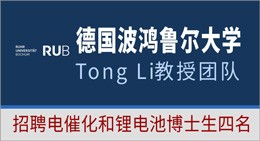当前位置:
X-MOL 学术
›
Adv. Funct. Mater.
›
论文详情
Our official English website, www.x-mol.net, welcomes your
feedback! (Note: you will need to create a separate account there.)
Surface Work Function Modifier to Modulate Electrolyte Decomposition on Negative Electrode in Lithium-Ion Batteries
Advanced Functional Materials ( IF 18.5 ) Pub Date : 2024-03-14 , DOI: 10.1002/adfm.202401620
Jooeun Byun 1 , Chae Rim Lee 1 , Wontak Kim 1 , Min A Lee 1 , Ho Yeon Jang 2 , Chihyun Hwang 1 , Jun Ho Song 1 , Ji‐Sang Yu 1 , Seoin Back 2 , Ki Jae Kim 3 , Hyun‐seung Kim 1
Advanced Functional Materials ( IF 18.5 ) Pub Date : 2024-03-14 , DOI: 10.1002/adfm.202401620
Jooeun Byun 1 , Chae Rim Lee 1 , Wontak Kim 1 , Min A Lee 1 , Ho Yeon Jang 2 , Chihyun Hwang 1 , Jun Ho Song 1 , Ji‐Sang Yu 1 , Seoin Back 2 , Ki Jae Kim 3 , Hyun‐seung Kim 1
Affiliation

|
The persistent decomposition of electrolytes on graphite and silicon electrodes in lithium-ion batteries (LIBs) is typically mitigated by the formation of a solid electrolyte interphase (SEI). However, the inadequate formation and chemo-mechanical degradation of SEI leads to re-exposure of electrode to electrolyte, contributing to the deterioration of LIBs. To address this issue, tris(2,4-pentanedionato)indium(III) (InAc) is incorporated into the work function tailoring additive. While conventional additives strengthen the chemo-mechanical properties of SEI through compositional modifications derived from specific elements, InAc uniquely alters charge transfer across the electrode surface, facilitated by high or low work function layer. This additive establishes an interlayer between the SEI and graphite/SiO surfaces, attributed to its tailored lowest unoccupied molecular orbital energy level. Consequently, the exposure of graphite surface to the electrolyte is minimized by interlayer during cycling. The interlayer possesses a higher work function than lithiated graphite and suppresses further electrolyte decomposition on graphite. In contrast, the interlayer on SiO decreases work function of SiO surface, which promotes the formation of inorganic SEI on SiO. Hence the degradation of SEI is suppressed with LiIn layer at SiO electrode. This leads to a reduction in the ongoing accumulation of SEI, thereby enhancing durability of LIBs.
中文翻译:

用于调节锂离子电池负极电解质分解的表面功函数改性剂
锂离子电池 (LIB) 中石墨和硅电极上电解质的持续分解通常可以通过固体电解质界面 (SEI) 的形成来缓解。然而,SEI 的不充分形成和化学机械降解会导致电极重新暴露于电解质,从而导致锂离子电池的劣化。为了解决这个问题,功函数定制添加剂中加入了三(2,4-戊二酮)铟(III) (InAc)。传统添加剂通过源自特定元素的成分改性来增强 SEI 的化学机械性能,而 InAc 独特地改变了电极表面的电荷转移,并由高或低功函数层促进。该添加剂在 SEI 和石墨/SiO2 表面之间建立了一个中间层,这归因于其定制的最低未占据分子轨道能级。因此,在循环过程中,夹层最大限度地减少了石墨表面对电解质的暴露。该中间层具有比锂化石墨更高的功函数,并抑制石墨上电解质的进一步分解。相反,SiO2上的中间层降低了SiO2表面的功函数,从而促进了SiO2上无机SEI的形成。因此,SiO 电极上的 LiIn 层抑制了 SEI 的降解。这会减少 SEI 的持续积累,从而提高 LIB 的耐用性。
更新日期:2024-03-14
中文翻译:

用于调节锂离子电池负极电解质分解的表面功函数改性剂
锂离子电池 (LIB) 中石墨和硅电极上电解质的持续分解通常可以通过固体电解质界面 (SEI) 的形成来缓解。然而,SEI 的不充分形成和化学机械降解会导致电极重新暴露于电解质,从而导致锂离子电池的劣化。为了解决这个问题,功函数定制添加剂中加入了三(2,4-戊二酮)铟(III) (InAc)。传统添加剂通过源自特定元素的成分改性来增强 SEI 的化学机械性能,而 InAc 独特地改变了电极表面的电荷转移,并由高或低功函数层促进。该添加剂在 SEI 和石墨/SiO2 表面之间建立了一个中间层,这归因于其定制的最低未占据分子轨道能级。因此,在循环过程中,夹层最大限度地减少了石墨表面对电解质的暴露。该中间层具有比锂化石墨更高的功函数,并抑制石墨上电解质的进一步分解。相反,SiO2上的中间层降低了SiO2表面的功函数,从而促进了SiO2上无机SEI的形成。因此,SiO 电极上的 LiIn 层抑制了 SEI 的降解。这会减少 SEI 的持续积累,从而提高 LIB 的耐用性。





































 京公网安备 11010802027423号
京公网安备 11010802027423号